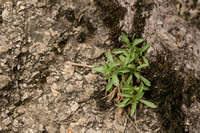Perennials or subshrubs, 4-30(-70) cm (cespitose; thickly taprooted, sometimes with woody caudex branches or rhizomes). Stems erect, branched or simple, puberulent or glabrous. Leaves cauline (proximal usually with evident internodes, sometimes congested, and spreading at right angles or angled distally); alternate; sessile; blades (1-nerved) spatulate (proximal) or linear to narrowly oblong or elliptic-lanceolate, mostly even in size and shape (stiff), margins entire, faces hispidulous to puberulent or glabrous (glandular in I. caelestis). Heads radiate, borne singly, sometimes 2-3+ in loose, corymbiform arrays (on simple branches originating beyond midstems). Involucres broadly turbinate to campanulate, (4.5-13 ×) 10-15 mm. Phyllaries 20-60 in 2-6 series, appressed, 1-nerved (midnerves usually indurate; strongly keeled), linear-lanceolate, unequal, herbaceous to indurate , without distinct herbaceous apical zones, margins scarious or not, glabrous or hirsuto-strigose, hirtellous, or loosely strigillose. Receptacles flat, pitted, epaleate. Ray florets 7-21 (in 1 series), pistillate, fertile; corollas violet to bluish, rarely white in I. linariifolia (laminae coiling). Disc florets 19-50, bisexual, fertile, functionally staminate in I. caelestis; corollas yellow, tubes shorter than narrowly tubular throats, lobes 5, erect to spreading, deltate; style-branch appendages lanceolate. Cypselae narrowly obovoid, flattened, ray (2-)3-nerved, disc 2(-4)-nerved, faces densely strigose to sericeous, eglandular or glandular; pappi persistent, in 1-2 series, outer of shorter bristles or scales, inner of 18-50 straw-colored, barbellate, apically attenuate bristles. x = 9.
Ionactis has often been included within Aster; its morphologic distinction has recently been reemphasized (G. L. Nesom and T. J. Leary 1992; Nesom 1992, 1994b). Plants of Ionactis are distinctive in their woody caudices, narrow, stiff, evenly distributed leaves, heads borne singly or in loose, corymbiform arrays, keeled phyllaries, flattened and slightly dimorphic cypselae, pappi of apically attenuate bristles with a shorter outer series, and base chromosome number of x = 9.






